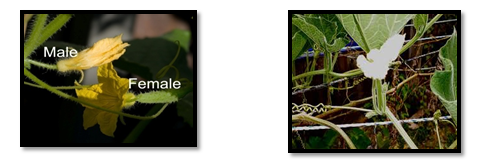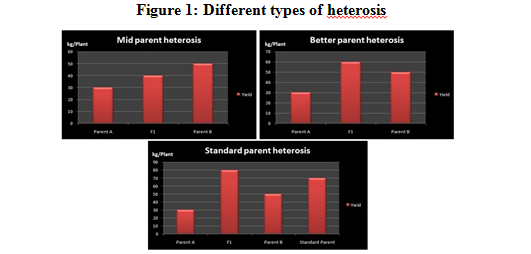Authors: Panchal Bhakti B.*, Dr. N. B. Patel, Dr. A. I. Patel, Dr. S. N. Saravaiya and Dr. R. V. Tank
ASPEE College of Horticulture and Forestry,
Navsari Agriculture University, Navsari396 450, Gujarat, India
Email: bhakti.b.panchal@gmail.com
Introduction:
Vegetables are Potential crops for improving nutrition, food security and also generate employment in the country (Rai and Yadav, 2005). Which are loaded with vitamins and minerals that contribute to growth and the maintenance of good health. It’s act as a cheapest source of natural protective foods and its grown easily in different farming systems. In short, it is summarized that systematic recommendation are available to make vegetable culture more profitable and enjoyable (Rana, 2012). Among the vegetable crops, cucurbits are distinct group where sex mechanism and sex expression are unique and are easily amenable for manipulation for production of F1 hybrids. ‘Cucurbits’ term was coined by L. H. Bailey (USA) for the cultivated species of the family Cucurbitaceae. The family Cucurbitaceae consists of about 118 genera and 825 species out of which about 15 different species of Cucurbitaceae are being commercially cultivated since long time. In which, high productivity is one of the important aspects of heterosis.
Cucurbits are cultivated in mixed cropping system, like river bed culture on river sand ‘Diara’- an unique, indigenous and improved system of vegetable forcing, which cover 60 per cent of the total area under cucurbits in this country. It is a family of significant economic importance with a number of edible vegetable species. The major genera of the family are Trichosanthes (100 species), Momordica (47 species) and Cucumis (34 species). There are about 36 minor genera which are monotypic.
Significance of cucurbits
• Annual
• Quick growing
• Cash earning crop in short duration
• Low requirement of inputs
• Cheapest source of nutrients
• Easy to grow
• Versatile use in the kitchen
Floral biology of cucurbits
Flowering in cucurbits normally starts in about 40-45 days after sowing depending upon the weather condition. The anthesis occurs in majority of cucurbits in morning some exceptions like, bottle gourd, ridge gourd and pointed gourd. The sequence of flowering follows a set of pattern, namely (i) Male phase (ii) Mixed phase (iii) Female phase.

Anthesis time of cucurbits mainly up to 5:30 to 7:30 a.m. (in yellow flowers) and 5:00 to 8:00 p.m. (in white flowers). Stigma receptivity is different to the species but, mainly before anthesis 24 hours and after anthesis 24 hours observed. Pollen Fertility is on the day of anthesis till the next morning. After 24 hours of pollination pollen tube reaches to the ovary and after 2-3 days ovary become a enlarged. Cross pollination is mainly by honeybees (60-80%).
Breeding objectives
• Early and higher yield
• Preponderance of female flower
• Desirable fruit shape, size and colour as per market & export potential
• Developing gynoecious and parthenocarpic hybrids
• Free from bitterness
• Light green & presence of inconspicuous hairs on skin (bottle gourd)
• Hybrid suited for canning and dehydration purpose (bitter gourd)
• Resistance to insects-pest and diseases
Table no. 1 Breeding methods for crop improvement in cucurbits
| Sr.no. | General breeding methods | Sr.no. | Special breeding techniques |
| 1 | Introduction | 1 | Mutation |
| 2 | Pure Line | 2 | Transgenic Breeding Technique |
| 3 | Mass Selection | 3 | Haploid & Aneuploid |
| 4 | Pedigree Method | 4 | Polyploidy |
| 5 | Backcross Method | 5 | Distance Hybridization |
| 6 | Heterosis Breeding | 6 | Tissue Culture |
What is heterosis ?
· Superiority or inferiority of F1 over the both the parents.
- Also called hybrid vigour.
Heterosis in Vegetables
· Hybrid vigour was first observed in cucumber for fruit size and number: Hayes and Jones (1916) at Japan.
· In 1942, Munger: First to highlight the possible utilization of F1 hybrids in muskmelon.
· In India, first report of hybrid vigour appeared in 1933 in chilli at IARI, New Delhi.
· First hybrid Pusa Meghdut of bottle gourd was developed by VBS, at Katrain (1971).
· Than after years the other hybrids were released in vegetable crops.
General features of heterosis
· Heterosis is a widely occurring biological phenomenon in both the plant and animal species.
· Heterosis is a genetically governed phenomenon.
· In plants, it has been reported to occur more frequently in a number of naturally cross-pollinated crop species as compared with self-pollinated ones.
· It has been observed that the expression of heterosis is usually more in hybrids obtained from genetically unrelated lines.
· The expression of heterosis is highly associated with specific combining ability of a cross.
- Heterosis is usually unfixable from generation to generation.
1. Genetic bases of heterosis
§ Dominance hypothesis (Davenport, 1907), Over-dominance hypothesis (Shull & East, 1908), Epistasis (Gowen, 1952)
2. Physiological bases of heterosis
§ Net Assimilation Rate, Leaf Area Index, Root Growth, Hormonal balance, Metabolic concept, Mitochondrial complementation
3. Molecular bases of heterosis
§ Intermediate amount of a single gene product, Separate gene products, Combined gene product, Effect in two different tissue, Expression of a greater no. of gene
Types of heterosis
1. On the basis of origin and nature
a. Euheterosis or true heterosis
i. Mutational heterosis
ii. Balanced heterosis
b. Pseudoheterosis or luxuriance
2. On the basis of types of estimation
a. Mid parent heterosis (average or relative heterosis)
b. Better parent heterosis (heterobeltiosis)
c. Useful heterosis (economic heterosis)
d. Standard parent heterosis (standard heterosis)

Important factors of heterosis
- Enough magnitude of heterosis
- High per cent age of out crossing
• Floral biology of plants
- Availability of MS and SI systems
- Higher yield
- Early maturity
- Large number of seeds per fruit
- Uniformity in size and shape
- Increase reproductive ability and quality
- Wider adaptability
- Produce gynoecious lines
- Better resistance
- Preponderance of staminate flower
- Production of less female flowers
- Sterile hybrid produced in interspecific cross
- Insufficient germplasm in different Cucurbitaceous crops
• Lack of competent scientific manpower to manage the research programmes
• Lack of pollinators due to cold, wet weather, pesticides, and habitat loss (ovary is not fertilized)
Future thrust
• Cucurbitaceous crops are important from export point of view. Develop F1 hybrids which can suit the requirements of international market.
- F1 hybrid of bitter gourd which can suit the requirement of value addition and processing industry.
• Develop parental/hybrid lines which are suitable for protected and off-season (winter) cultivation with better adaptability to variable environment.
References
1. Airina, C.K., Pradeepkumar, T., George, T.E., Sadhankumar, P.G. and Krishnan, S. (2013). Journal of Tropical Agriculture, 51 (1-2): 144-148.
2. Kanzaria, S. G. (2012). Thesis, M. Sc. (Agri.), Navsari Agricultural University, Navsari.
3. Laxuman, Patil, S.A., Salimath, P.M. and Dharmatti, P.R. (2012). Karnataka J. Agric. Sci., 25 (1): 14-17.
4. Mule, P.N., Khandelwal, V., Lodam, V.A., Shinde, D.A., Patil, P.P. and Patil, A.B. (2012). Madras Agric. J., 99 (7-9): 420-423.
5. Rai, N. and Yadav, D.S. (2005). “Advances in Vegetable Production”, Researchco Book Centre, New Delhi, p. 13.
6. Shaikh, J.A., Kathiria, K.B. and Acharya, R.R. (2011). Veg. Sci., 38 (2): 169-175.
7. Singh, A.K., Pan, R.S. and Bhavana, P. (2013). The Bioscan, 8 (4): 1533-1536.
8. Singh, R.A., Singh, K. Sanjay Kumar and Singh, B.K. (2012a). Indian J. Hort., 69 (2): 200-204.
9. Singh, S.K., Singh, R.K., Solankey, S.S. and Upadhyay, A.K. (2012b). Asian J. Hort., 7 (2): 303-306.
About Author / Additional Info:
Ph. D. Scholar (Horticulture)